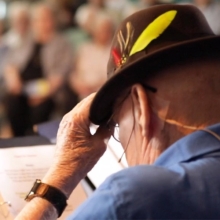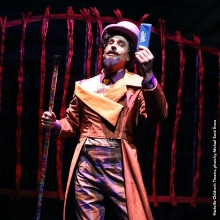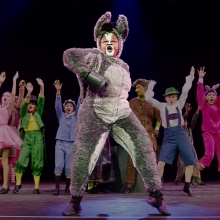Filichia Features: Don't Be Afraid of Follies

Filichia Features: Don't Be Afraid of Follies
They laughed. They applauded. They cheered. They stood.
Those were the responses from theatergoers at Follies at The Concord Players in Massachusetts. During intermission, attendees could be seen with big smiles on their faces, looking for their friends who’d been sitting in different sections. When they found each other, they cooed “Isn’t this wonderful?!”
An hour or so later, the sentence had only slightly changed to “Wasn’t that wonderful?” The same broad and satisfied smiles were again in place as the happy people exited.
Compare this reaction to the ones 1971 audiences gave the original Broadway production of Follies. “It was awfully hard to get through,” wrote Steven Suskin in his More Opening Nights on Broadway, after he’d remarked on the “droves who were driven away” and “spread the bad word to their friends.”
Ethan Mordden, who in his One More Kiss – named for a Follies song -- praised the show as “arguably the greatest musical of all time” but conceded that it had a “dangerous book” and a “controversial reputation” as a result of its dispensing “doom, yours and mine, and that’s hard to enjoy.”
Not now in Massachusetts. Not here in Concord. The performance was more proof, if any was needed, that Follies, a musical about the past, was ironically ahead of its time, and right for right now.
Forty-four years ago, members of “The Greatest Generation,” as the pre-Baby Boomers are called, didn’t like watching the miserable marriages of Ben and Phyllis Stone or Buddy and Sally Plummer. In a show that would become famous for its “mirror number,” many theatergoers saw their own marriages, which ranged from boring to contentious, mirrored in these four people.
“Why,” they asked themselves, “did we pay an exorbitant amount for theater tickets – they’re up to $30 a pair now! – to see spouses fighting and expressing bitter disappointment with each other when we can get that at home?” Indeed, many Follies “Greatest Generation” attendees may well have been brawling about these characters’ same matters of alienation of affection and/or infidelity just before they left the house to see the show.
Some wives could see themselves in Sally, who was in love with Ben but lost him thirty years earlier because he needed a trophy wife who could successfully host a dinner for ten elderly men from the U.N. That was the elite circle Ben wanted to crash -- and did.

Concord Players - Follies - Cast (Photo courtesy of Facebook)
So Ben picked Sally's more glamorous roommate Phyllis, leaving a distraught Sally to choose Buddy on the rebound. (One of the many lessons to be gleaned from Follies: DO watch out for that rebound thing.) Now Sally would attempt to break up the Stones’ unholy alliance without worrying about her own husband’s feelings. Ben would offer her a one-night stand but nothing more.
Never mind that Stephen Sondheim interrupted the Stones’ and Plummers’ devastating verbal battles with many more happy-go-lucky people performing magnificent songs. After all, Follies was set at a reunion (in the about-to-be-razed theater where many of our characters once performed), and most people who attend such an event are there, as host Dimitri Weismann says, “to glamorize the old days, stumble through a song or two and lie about ourselves a little.”
Actually, Ben, Phyllis, Buddy and Sally have been lying quite a bit over the years. Tonight it stops as all four tell the truth about sexual flings and a lasting affair. And this musical that became famous for having ghosts of people past on the stage made 1971 theatergoers remember their own ghosts. Plenty were saying to themselves, “Right down the street, that musical of Some Like It Hot is playing. Why didn’t we go there and have fun?”
Remember, too, that even in 1971, millions of couples that had reached middle age in both years and marriages still believed that divorce was the very last of last resorts. It was too great an admission of failure. That’s why “The Follies Four” makes the decision at the end of the show to stay married for better (unlikely) or worse (inevitable).
Now, however, in 2015, the Concord audience was filled with Baby Boomers who grew up witnessing first-hand those disappointing marriages. They didn’t agree with Mom and Dad’s staying put “because of the kids” or the belief that the devilish mate you know is better than the one you don’t. Baby Boomers have traditionally wanted and expected more out of life and have been less concerned with what the neighbors – or even relatives -- think. Divorce, while still no metaphorical stroll in the park, has never been an unthinkable and humiliating fate for this group. Many have endured it and have come to believe that it is, as another Sondheim musical calls it, “the best thing that ever could have happened.” Long before they split with their spouses, they were ready to – let’s quote yet another Sondheim musical -- “move on.”
What’s more, the Concord theatergoers could slough off the Plummer-Stone issues as problems of “The Greatest (Except in Matters of Marriage) Generation,” not theirs. So if you’re a director who’s been reluctant to mount a production of Follies because you’ve heard about that tough initial reception, you’ll probably find that the audience of today will be intrigued and not devastated.
However, Follies is not an easy show to do – which made director Donnie Baillargeon’s superb production and Jennifer Condon’s excellent choreography all the more impressive.
David Warnock revealed that Ben is the serious version of J. Pierrepont Finch in How to Succeed... Lea Oppedisano was a statuesque Phyllis while David Berti showed great sincerity as Buddy. Sally may only be able to remember being “young and beautiful,” as she sings “In Buddy’s Eyes,” but Margaret McCarty recaptured both qualities when doing the number.
And in all the musicals I’ve seen, Bennett’s original “Who’s That Woman?” still ranks as The Best Production Number of Them All. No wonder that in the nine subsequent productions I’ve seen, nine choreographers have pretty much stayed with his template, as did Condon here.
As always, the audience went ca-razy at this “mirror number,” seeing the late-middle-aged women trying to recapture the past while the ghosts that represented their younger selves effortlessly danced behind them. No choreographer should worry if one, two or more ex-showgirls are a beat, two or more behind. As one of them says, “I haven’t danced in 30 years.” No problem, then, if any of them look it.
Of course, such an exacting number will mean that your older women will be mighty winded by the time they finish it. They’ll need time to catch their breaths, but considering the titanic amount of applause this number always (and I mean always) gets, they’ll have nearly a minute to recover.
They may have had even longer in Concord. As Stella Deems, Jennifer Bubriski knew how to center the number and held a solid center stage. Her expert performance substantiates a point about the show that makes producing it a little easier: FOLLIES’ featured female characters do “the mirror number,” get one solo each and then are window-dressing for the rest of the night. This gives your actresses plenty of time to perfect the comparatively little they do – and perfect it these women did in Concord.
Marian Morrison, playing former chanteuse Solange La Fitte, went easy on the potage-thick French accent we usually hear in “Ah, Paris!” That allowed us to hear every clever Sondheim rhyme that we usually miss. Sheila Rehrig put Carlotta in her own little reverie when she sang The Best Song Ever Added Out-of-Town: “I’m Still Here.” When she delivered the lyric “sung the blues” she underlined the verb as “sunnnng,” which provided the right bluesy feeling.
As Hattie Walker, Lisa Huntington had an excellent moment in “Broadway Baby” that was new to me. On the final word on the lyric “Waiting for my one big chance to be in a show,” she stomped her foot hard, so the “Oh!” that followed wasn't just a word that rhymed but a cry of pain she emitted as a result of hurting her leg. (Her idea? Baillargeon’s? Someone else’s?) This also suggested that Hattie in her youth had stamped that foot with great abandon and felt no pain -- then.
Granted, some of your usual women stars may feel shortchanged by being showcased in just one number, but a cameo in Follies, replete with a dynamite song, is worth a lead in many another musical. So do Follies and reveal that it’s now a popular success as well as an artistic triumph. You’ll be so proud of yourself if you pull it off.

























